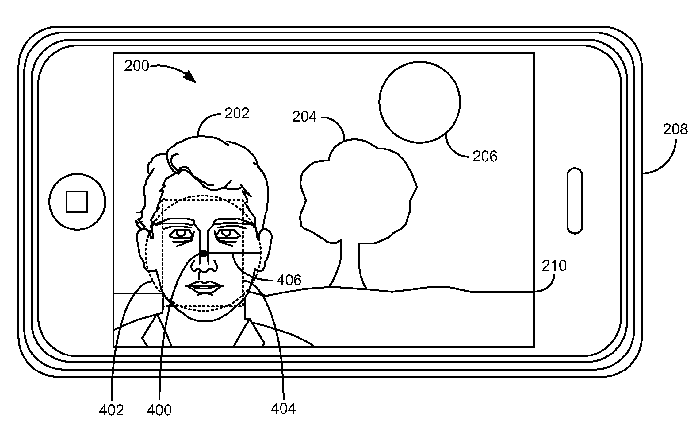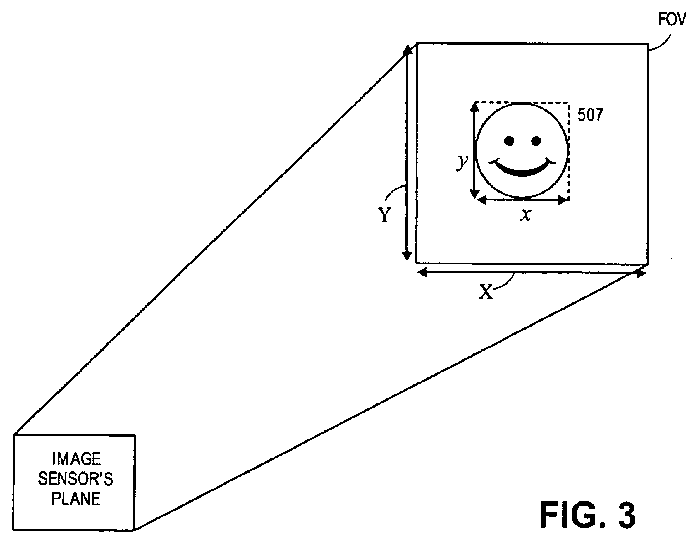Apple wins auto-focus speed, exposure metering camera patents
Apple's U.S. Patent No. 8,233,789 for "Dynamic exposure metering based on face detection" describes a system and method of automatically changing a digital camera's exposure settings based on a subject's face while U.S. Patent No. 8,233,078 for "Auto focus speed enhancement using object recognition and resolution" uses similar object-detection software to hasten focus speed.
It should be noted that both of Tuesday's patents rely on face or object-recognition assets which are already found in iOS 5.
The '789 patent, first applied for in April 2010, offers a method to automatically adjust the exposure of a digital image by metering a face detected in the picture's frame.
Apple notes the invention could prove useful in situations where a background's lighting is in high contrast relative to the subject. In such cases some automatic metering systems fail because they take an average or weighted average of the complete frame meaning the usually larger background could throw off the exposure. To overcome the limitations of existing metering technologies, the invention employs facial recognition software which the camera uses to apply the appropriate exposure. Continuous metering is also covered by the patent, allowing users to simply open an app, point and shoot.
Face detection-based metering. | Source: USPTO
From the abstract:
In one embodiment disclosed herein, a face detection algorithm is run on the current picture or video frame, and the exposure metering region is inset over the detected face. Exposure time, gain, or other exposure parameters may be set based on the pixels within the exposure metering region. In another embodiment, the exposure metering region tracks a moving face according to lag parameters so that the exposure metering region remains substantially over the face. In yet another embodiment, a plurality of faces may be tracked, with the exposure parameters set based on a weighted average of the pixels within the plurality of face-containing exposure metering regions.
The patent helps to make digital cameras found on many "personal electronics" like smartphones more usable as the units are smaller and less feature-rich than dedicated photography devices.
In the '078 patent, an interesting autofocusing method is described where a processor detects a face in a captured image and selects the correct lens position for optimal focus based on calculations of the face's size.
The invention selects the appropriate setting for a moveable lens system by comparing a subject's face with "stored face sizes" which are associated with corresponding "in-focus" lens positions. Field of view is also taken into consideration in the patent's claims.
From the patent claims:
8. […] determining angle of view used when capturing the image; and selecting a group of previously stored face sizes and associated lens focus positions, from amongst a plurality of such groups, that are associated with the determined angle of view.
9. […} calculating field of view used when capturing the image, and wherein calculating the size of the detected face comprises measuring the area of the detected face in relation to the calculated field of view.
10. The method of claim 9 wherein calculating the size of the detected face comprises calculating a ratio of the measured area of the detected face to the calculated field of view.
11. The method of claim 8, wherein calculating the size of the detected face comprises measuring dimensions of the smallest rectangle or square in which the detected face fits.
Apple notes the invention saves time by eschewing the sweep of positions a moveable lens assembly goes through to find optimal focus in some existing autofocus systems. Instead of moving through a number of positions to gather focus values, the '078 patent allows a lens assembly to "jump directly to a lens position that is expected to result in a sharp picture of the scene, without having to go through a full sweep of lens positions."
 Mikey Campbell
Mikey Campbell












 William Gallagher and Mike Wuerthele
William Gallagher and Mike Wuerthele
 William Gallagher
William Gallagher
 Wesley Hilliard
Wesley Hilliard
 Andrew Orr
Andrew Orr



 Amber Neely
Amber Neely







